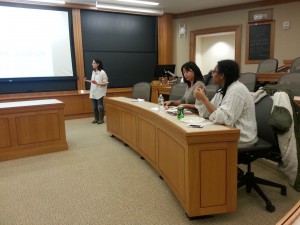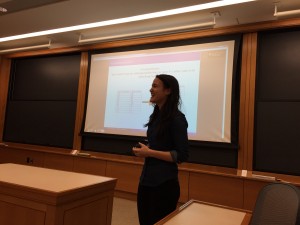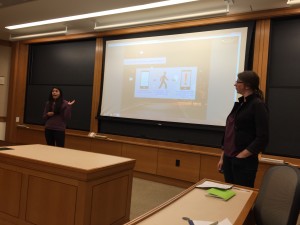This week we have only a short update, as it has been a busy time for courses. Cindy and I began planning based on Joel’s suggestions for actionable areas to help Food for Free. In the meantime, we are examining existing technology solutions for tablet and phone APIs that allow SMS notifications to an organization (in the vein of Uber’s texts when your driver has arrived or is on their way). We are also hoping to coordinate a trip to highly-effective packing grocer, and planning another meeting with the operations manager to discuss our ideas.
21st Century Girlhood Week 6
What we did
This week we created an email and tumblr page, setting the foundations for our final project. The name we chose is “girlhoodbyus.” In the process of creating our page we wrote our mission statement and designed the layout. Additionally this week we met with an oral historian, Charlotte Krontiris, to discuss the ways in which we could incorporate this medium into our final project. We discussed the proper ways to conduct an oral history interview and powerful ways to incorporate clips of interviews into a larger project.
What went well
We are pleased with the format for the blog we created and feel it conveys the tone of our project well. Additionally we found the discussion with Charlotte very helpful and interesting. Because of her insight we are now rethinking about how to conduct our upcoming focus group.
What was challenging
Deciding upon a name and layout for the blog was challenging. There were a lot of options, but neither of us has a wealth of knowledge regarding tumblr format. Also we wanted to make sure that the blog conveyed our mission statement and description clearly, so that it would not get lost amongst all of our future posts.
What’s up next
Next we want to add more posts to our blog page. We are planning on using some of our own personal quotes along with ones we pulled from our previous focus group. Additionally we have two more focus groups coming up in April and hope to use them to create more diverse postings for our blog.
Food for Free: brainstorming solutions
Hi all!
A few ridealongs later, Soraya and I finally felt ready to start drafting possible solutions that we could work towards in the remaining semester.
These are the opportunities we’ve observed at Food for Free:
1. More brand associations
2. Greater involvement from the donor agencies
3. Advanced communications between drivers and food recipients
4. Getting drivers’ buy-in to change
5. Technological solutions that alleviate workload (as opposed to adding)
6. More strategic with donor partnerships
Of the above, we decided we could tackle opportunities #1, #2, and #3.
Opportunity #1 or increasing branding should be relatively low effort, so we are not too concerned over that.
Opportunity #2 or raising donor involvement, however, may be more difficult, given donors are decentralized with their own processes. We are going to study the operational process of the best donor, a Trader Joe’s in Cambridge. From there, we will put together best practices and process flows that can be shared with other donors. Additional aspects to this would be assigning a point-person for accountability at each donor site and to more strongly communicate end-user impact to these donors.
Lastly, we foresee moderate level of effort with Opportunity #3 or adding advanced communications with partners. We will be looking into texting solutions so drivers can easily notify recipients prior to arrival. We would like to include drivers at every stage of the design so maximize buy-in of the new technology.
More to come next week on our progress!
Cindy and Soraya
21st Century Girlhood – Week 5 + 6
With a week off from school for Spring Break, we too took a break from all things 21st Century Girlhood. Now that we are back, we are ready to get back in the swing of things and start tackling our project again.
First up, we are going to have a tutorial on how to construct oral histories. Oral histories are a way of documenting history through planned interview and they are a possible format for our project. We are really looking forward to learning more about oral histories and how to go about constructing them.
Up next, we hope to have more focus groups soon. Our last one was very informative and talking to a greater range of age groups will be even better.
21st Girlhood Week 4
What we did
This week we held our first, of hopefully many, focus groups. We sat down with about eight girls ranging from seniors in high school to freshmen in college and posed to them our broad question, “What does girlhood mean to you?” This sparked a lively discussion of many facets of girlhood including the idea of girls in leadership, third wave feminism and social media. We then moved on to discussing the various forms and effectiveness of campaigns focused toward younger girls. Ultimately, we reached the conclusion that campaigns that focused more on things girls could control, rather than telling people how to treat or not treat girls, were more impactful. Finally we talked about potential platforms for our final project and the discussion reinforced our original idea of a mixed media and submission based website.
What went well
The focus group was extremely helpful and productive. We feel as if we have more tangible ideas for our project and clearer ultimate direction.
What was challenging
It was challenging to focus the group and separate the genuine reactions of people from the general attitude of the group or even the cultural dialogue surrounding some of these issues.
What’s up next
Next we need to more firmly commit to a final project direction and hopefully set up some more focus groups with a wider age range of girls.
Food for Free: Meeting the drivers
On Wednesday, I attended Food for Free’s weekly staff meeting with three of the five drivers, and the Operations Director. I introduced myself and the project. I listened to what they chatted about during these sessions, and occasionally asked questions to explore shared frustrations among the team. After learning about some of the pain points that the three drivers identified, I took notes on their feedback. I asked the Operations Director for a sample day of what Friday’s ride along would look like from their database, and plotted the drop-off and pick-up points using Google’s My Maps feature. I attempted to draw out routes based on proximity, and used this map as a point of comparison and preparation for the upcoming ride-along.
On Thursday, Cindy and I presented during the mid-term review, sharing our progress so far. As mentioned during the review session, we are still in the process of determining what problems we can address, as the team meeting and ride alongs have further illustrated a breadth of inconveniences. We also gained some insight into the volunteer management system as we prepared for our individual ride alongs.
On Friday, I accompanied one of the drivers and a regular volunteer on a full-day pickup and delivery run–it was a really enjoyable experience, and they were a pleasure to talk to. We met at 8am at the Food for Free office, and started loading the truck from the office. I informally asked questions throughout the drive and learned more about some of the difficulties of the job, how orders are processed, how technology is used by the drivers and staff, how routes are determined, and so on. They provided interesting insights on problems they encountered while on the job, and gave great food for thought on possible solutions. I helped load and offload materials and gained some insight into the physical struggles and strains drivers and volunteers regularly endure. Throughout the experience, I took photographs and some videos to have an internal archive of what the drivers and volunteers regularly do during a lighter-load day (Friday’s transport was an approximately 1,500lb load, whereas a heavier day might mean 9,000lbs). During the ride, I used Map My Run to track truck movements, and to get a sense of the timing of deliveries and transit. After the ride along, Cindy, Joel and I met to discuss the experience, our future plans with the organization, and how we might be able to help Food for Free from these observations.
In the future, Cindy and I will look through some of the maps (Google’s My Maps, and the Map My Run path) to get a better sense of how the team works together and coordinates the movement of food.
Spring Mid-Semester Review
On Thursday, the six DPSI teams gathered to eat Indian food and talk with mentors and members of the Berkman community about the progress they’ve made so far this semester and where they’re going next.
We heard from the Systemic Justice team, who showed us their draft mock-up of a site that would house law and policy papers on a variety of social justice issues, and we talked about goals for user interaction and how that will impact their design.
The 21st Century Girlhood team is looking forward to their first focus group with high school and college-aged women, which will be taking place this week. They told us about some of their plans for the group and how the outcome will be crucial in determining what they want their product to be.
The Big Data team’s Olivia is a seasoned presenter after last semester with DPSI and the recent Berkman Center lunch talk! She reminded us how k-anonymization works in record time, and answered questions about potential future privacy measures.
The Food for Free team outlined the questions they’re asking about efficiency and problem spots in the food redistribution non-profit they’re working with. The team is looking forward to ride-alongs and interviews with the organization’s drivers coming up in the next week so they can get a first-hand look at the problems and inefficiencies.
The SafeCampus team continues to work on their BonoboApp, and is thinking through issues of privacy and incentivizing through their design.
DocShop is thinking about funding as they approach their end-of-semester show as well as how to collaborate with and assist artists while maintaining their own separate projects and identity. Together, we talked about what makes an interactive documentary and how DocShop’s analog focus is unique.
Thanks to all the teams for their hard work, and we’ll see you after spring break!
21st Century Girlhood – Week 3
What we did
During our meeting this week, we continued to flesh out our ideas of what we want our project to be. We decided that we will pursue a multimedia platform — possibly a “tumblr-esque” blog. We also worked out the details of our focus group that we will be having this Friday.
What went well
Every new detail that we nail down is a huge step towards turning our unformed ideas into something real. We’ve even started thinking of domain/blog names for our project.
What was challenging
Our biggest challenge now is preparing for our focus group. This will be my first time facilitating one so it will interesting. We need to focus on about what we want to gain from it and what questions we want to ask the group.
What’s up next
We are really excited about our upcoming focus group. Having the chance to talk to high-schoolers will give us some direction on what type of project would be most meaningful to them.
Food for Free: Assessing the numbers first
Hello!
Cindy and I asked Food for Free’s Operations Director to look through some of their data. They provided information from their operational database, such as locations of pickups and drop-offs, inventory present, and times of movement. We hope that we can help map out where drivers spatially move during the course of their day and better understand their organizational flow, before accompanying drivers on the delivery trucks and getting a sense of how that manifests physically and emotionally.
Though we were unable to meet with the Food for Free team last week, we are planning introductions with the drivers and full staff on Wednesday, and accompanying drivers later this week. We’re really looking forward to meeting the drivers and hearing their stories, and seeing how that informs the project.
Our next check-in will be with more stories of things learned from the data, and time with the drivers.
SafeCampus Spring Semester Week 2
This week we drafted a new plan about how to move forward. Our team got a little bit smaller, so our biggest challenge was trying to figure out the best way to move forward with the project. We came up with a solution and feel as though we have a strong plan to continue progressing. We have decided to focus on the online survey that we drafted last semester. Our goal is to edit it and create a list of contacts that we will send it out to. We have also discussed what would be the best way to contain and save the data that comes through from the survey.
We also presented our project at the Berkman Center for Internet & Society Luncheon. We received many questions and suggestions about the status of the app’s development, people to get in contact with, incentivizing it and privacy issues.



